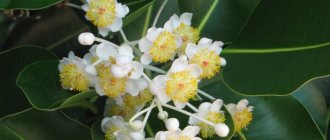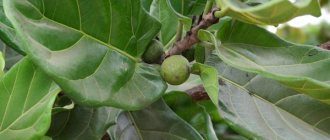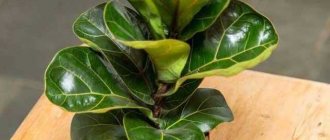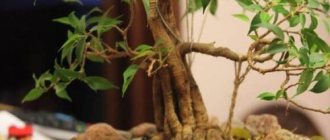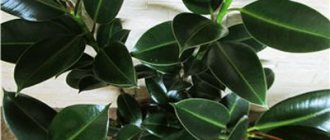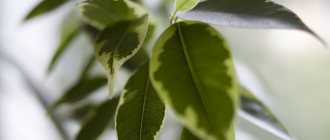Home care
Lighting
Bright light is needed. The best lighting will be provided by windows facing southeast, south or southwest.
“Summer vacations” in the open air of a balcony or area with mandatory protection from the scorching midday sun are useful.
Temperature
The best summer temperature range is from 20 to 25 degrees ; winter temperature should not be lower than 15 degrees.
ATTENTION : Drafts are contraindicated, as are frequent rearrangements.
REFERENCE : summer keeping in the open air can also cover part of the autumn, since this ancient, viable and hardy species is able to withstand even small short-term frosts
Priming
The optimal soil substrate should be slightly acidic or neutral, sufficiently loose and nutritious.
You can use ready-made soil for ficus plants, or mix two parts of turf and leaf soil with one part of coarse sand.
The following composition is also recommended:
- turf, leaf, peat soil with sand;
- all ingredients in equal quantities.
Planting and transplanting
The container for planting can be of a standard shape: (the vertical size is from a quarter to a third of the height of the plant), with a mandatory drainage hole.
Since stagnation of water is extremely unfavorable, leading to rotting of the roots, it is better to choose a porous material for the container - ceramics without a continuous layer of glaze.
A drainage layer of small pebbles or expanded clay must be placed at the bottom of the container.
During planting, as you fill up the soil, when filling the voids between the roots, you must be careful not to bury the root collar of the plant: it should be level with the ground. If the plant is tall, you need to take care of support for its trunk.
After planting, the ficus should be watered.
Young plants are replanted annually in spring or early summer, and mature specimens - once every few years , and the signal for replanting is the complete entanglement of the earthen coma with roots. Then the plant is transferred to a new pot, preserving the earthen lump.
ATTENTION : To limit the growth of this potentially large tree, it should not be transplanted into overly spacious pots: for young ficuses, the diameter of the new pot should be only 2 cm larger than the previous one, and for mature ones - 6 cm.
Large adult plants are not replanted, limiting themselves to replacing the top layer of soil in the container.
After purchase, in any case, the plant is not replanted immediately, giving time (from two weeks) to acclimatize to the new conditions for it.
Tip: If your “new baby” arrived in a cramped pot for transportation and in a special transport soil, it should be replanted in a container of a suitable size with a nutritious soil mixture.
Watering
In the summer, water, as a rule, once or twice a week with well-settled, soft, not cold water, avoiding stagnation of moisture.
Excess irrigation water accumulating in the pan is immediately drained.
The frequency of winter watering is from weekly to twice a month: the cooler the winter, the less frequent the watering.
Air humidity
It is necessary to maintain high air humidity, similar to the conditions in which this ficus grows in nature.
In summer, daily spraying with soft water at room temperature is mandatory.
The leaves are wiped weekly with a damp soft sponge.
In winter, if the air is not very dry, spraying can be replaced by wet wiping.
Top dressing
From spring to autumn, twice a month, fertilizing is carried out alternately with mineral and organic complexes, while ensuring a high nitrogen content.
Important : Fertilizer solutions should not come into contact with leaves and buds.
If the winter is warm, fertilizing is not stopped.
If kept cool and light, feed less frequently in winter.
Growth and pruning
The large-leaved ficus grows very quickly and, if its growth is not limited by pruning, it may very soon try to break through the ceiling.
Mandatory annual pruning, in addition to limiting the height of the plant, stimulates branching and the formation of a more luxuriant crown.
This operation is carried out in early spring.
When pruning thin shoots, straight cuts above the bud are used, and for thicker shoots, oblique cuts are used.
On ficus plants located in a sufficiently humid environment, aerial roots form.
They are not removed, but, as they grow, are directed to the soil surface.
Thanks to its rapid growth and active branching after pruning, this giant is an excellent material for creating spectacular bonsai trees - but only large ones, no less than a meter.
In this case, replaceable wire frames, targeted trimming, and tension support systems are used.
With age, the bark of the large-leaved ficus becomes very dark.
Other types of ficus are also suitable for growing magnificent bonsai trees, such as Ginseng, Microcarpa, Eden, Benedicta, Carica, Bengal, Lirata, Balsamina, Retusa and Blunt, the features of caring for which we talked about in separate articles on our portal.
Caring for young seedlings
Almost every gardener knows how to propagate ficus by cuttings (photos of the plant are presented in the review). However, only professionals know how to properly care for young seedlings. For example, in order for them to hatch, you will need to maintain the temperature around 22-23 degrees. It is also strictly forbidden to allow direct sunlight to fall on the seedlings, so that the seed material does not simply “cook” and die.
The first shoots usually begin to appear after 1-2 months. As soon as they get a little stronger (3-4 days), you need to start removing the greenhouse for several hours a day so that the plants do not experience strong temperature changes. Watering is carried out using a spray bottle until 3 young leaves appear on the sprout. After this, you can begin to care for the ficus as an adult plant. Transplantation into separate containers is possible after 8 days.
It is not difficult to guess that this method of reproduction is very unpopular, since it requires quite a lot of time. In addition, the percentage of seed germination is slightly more than 30% - quite low for an indoor crop. Therefore, beginning gardeners should use vegetative methods, which are simpler. In addition, the daughter plant obtained from the cutting retains all the qualities of the parent.
How to propagate ficus macrophylla?
Ficus is propagated vegetatively - by cuttings and air layering.
Propagation by cuttings
Spring and summer cuttings are used: apical cuttings 10-15 cm , as well as stem cuttings with several leaves.
Wash off the milky juice that appears on the cuts.
The lower leaves are removed, and the rest are wrapped in a not too tight tube and secured in this state to reduce evaporation through the surface of the leaf plate.
You can pre-root the cuttings in water or immediately plant them in a light soil mixture.
The prepared cuttings are planted in a soil substrate made of equal amounts of perlite, or coarse sand and peat, covered with plastic film.
Keep at a temperature of 22-24 degrees , ventilate and moisturize.
After the roots have formed and new shoots have appeared (after about a month), the cuttings are planted in separate containers with the usual soil mixture for ficuses.
Reproduction by air layering
Before the beginning of the growing season, at the end of winter, an incision is made on a semi-lignified or completely lignified shoot, the area is wrapped in moist sphagnum, covered with plastic film and secured.
The moss must be constantly moist.
As a rule, after a month roots appear, growing through the sphagnum.
Then, having separated the tip of the shoot along with the sphagnum and the resulting root system, it is planted in a pot with a standard soil mixture.
Signs of trouble
Leaves fall - the result of insufficient lighting, drafts, frequent rearrangements, as well as temperature fluctuations and waterlogging.
Optimal care must be provided. The same can be observed in a recently purchased specimen that is experiencing stress due to a sudden change in living conditions.
The tips of the leaves have turned brown and dried out - the air in the room is too dry.
Spraying required.
The leaves turn yellow - this is a consequence of a number of reasons:
- Excessive application of fertilizers. Eliminated by abundant watering, after which fertilizing is not applied for two months;
- precipitation of large amounts of salts due to watering with hard water. In this case, replanting with soil replacement is necessary;
- the volume of the pot is too large. Needs replanting into a smaller container;
- Root rotting.
Damaged areas of the root system should be removed and the plant should be replanted in fresh soil.
If the process has gone far, you can try cutting and rooting the cuttings and eliminating the rest of the plant.
Slow growth - can be caused by a lack of light, feeding or too tight a container.
It is necessary to optimize the conditions of detention, allocate a more spacious container.
Ficus: description of the genus
Most species are epiphytes, forming aerial roots that, sinking into the soil, give rise to a new plant. The shape of the leaf blade is very diverse: with jagged edges, oval, heart-shaped, xiphoid or with a pointed end. Ficus trees contain a special white juice - milky, used in medicine, but if it comes into contact with the skin, the secretions of some species can cause irritation. The inflorescences are also different, they are grouped or grow separately, representing a dense ball with a hole in the upper part. Small flowers appear inside the sphere. At home, ficus trees bloom extremely rarely, since insects are needed for pollination. The fruits look like small nuts with pulp and many seeds.
Photo
In the photo there is a large-leaved ficus:
Ficus plants amaze with the variety of their species, and some of them are truly spectacular and charming. Want to make sure of this? Read our articles about the bright De Gantelle, the mysterious Varietis, the popular Moklama, the capricious Dwarf, the graceful Pumila White Sunny, the tropical Ampel, the royal Amstel King, the comfort-giving Triangular and the hardy Ali.
Propagation using a leaf
Don't know how to propagate large-leaved ficus leaves? Then the information in this section will come in handy for you. It is worth noting that propagating ficus leaves is the most preferable procedure for a beginning gardener, since it does not require much time and effort. In addition, the percentage of rooting in this case is much higher than in the previous one, and preparing planting material will not be difficult.
First, we prepare a cutting with a large leaf. As in the previous case, preference should be given to planting material that has already become quite lignified. The cutting is cut at an angle of 45° with a sharp knife at a distance of 5 centimeters from the base of the leaf. After this, it is necessary to treat the cut with a root formation stimulator and immerse the cutting in water. For ease of care, you can roll the sheet into a tube and tie it with thread.
Don't be afraid to shorten the leaf by cutting off most of it if it turns out to be very large. Such actions will help to significantly reduce the rooting time, since the plant will not spend too much energy maintaining the vital activity of unnecessary parts. As soon as the first roots appear on the shoot (2-3 weeks), the cutting is placed in a substrate with previously prepared soil. To create a greenhouse effect, you can use a plastic bag.
Diseases and pests
Care errors, primarily stagnation of water and excessively humid air, combined with low temperatures, lead to weakening of the plant and its damage by fungal infections.
In this case, you need to optimize watering, spraying, temperature and treat the ficus with fungicides.
Ficus can be attacked by mealybugs, spider mites and scale insects.
Prevention against such “guests” is regular washing of the leaves, but if insects appear, the first measure is to remove the pests using a cotton swab dipped in alcohol or treatment with a soap solution.
Advice : The most effective remedy for pests is systemic insecticides.
Ficus Binnendi Ali
This is a fast-growing and rather large ficus. In the natural environment, ficus grows up to 20 meters, but in room conditions - only up to 2 meters. The leaves are greenish in color, not wide, but long. Ficus is easy to care for, even beginner gardeners can do it. The main thing when growing this variety is regular moisture, light, replanting and fertilizing. The plant is propagated using cuttings, which is also easy. The ficus is branched and will delight you with its decorative appearance after formative pruning, which allows you to give the crown the desired appearance.
Popular varieties:
- Amstel Queen - thin leaves of large size, rich green color;
- Amstel Gold - the variety is distinguished by its variegation and double color of leaves: green and yellowish;
- Amstel King is a branched plant; formed by cutting into a spherical shape. The foliage is greenish in color.
Reproduction by cuttings
Ficus large-leaved, which is at least two years old, is suitable for this method. The Rubiginosa variety reproduces well using this method. Cuttings are best carried out in the spring - by autumn, the young large-leaved plant should already have a well-developed root system. A day before you start harvesting cuttings, the plant needs to be well watered, then the cuttings will be saturated with juice and will be more viable.
For propagation, a 10–15 cm cutting from the upper part of the plant, preferably already semi-woody, is suitable. Large-leaf ficus trees can also be propagated by cuttings from the middle part of the stem, not necessarily the top. It should contain 2-3 leaf nodes.
It is better to use a sharp knife for cutting - pruning shears can damage the tissue of the cutting, which will complicate the rooting process. The cut is made at an angle of 45 degrees.
If you are propagating large-leaf ficus, leave 2-3 small top leaves on the cuttings. If they are large, you need to twist them or cut off half of each - this will help the cuttings retain moisture, which is important when propagating.
Ficus dwarf or creeping
The second name for the ampelous ficus is pumila. In its natural environment, ficus is a groundcover perennial plant that occupies up to 4 square meters of area. The leaves are small in size, rounded with a pointed tip, up to 3 cm long. The leaves are greenish or variegated. The shoots are elongated and drooping. The plant is unpretentious, loves a lot of light, but can also grow in shaded places. It is recommended to grow at 20-25ºС. Regular moderate watering is required as the soil dries out. The plant is branched; to form a lush ornamental bush, the shoots are shortened by 1/3 every year in spring.
Popular varieties:
- Sunny – greenish leaves with an intermittent whitish or milky rim;
- White Sunny – leaves have a white rim;
- Dorte - greenish leaves with white or milky spots.
Popular types of rubber ficus
Ficus elastica is known for its wide variety of varieties, differing in leaf size and color. All of them are more compact than natural species. The rubber ficus has a pleasant decorative appearance both in the photo and in life. The most popular varieties for growing in apartment conditions are the following varieties.
Robusta is famous for its wide, large, bright green leaves.
One of the most unpretentious varieties.
Belize - a distinctive feature of this variety is the tricolor color of the leaves. The center of the leaf is colored green, while along the edge there are white and pink streaks.
This type of ficus is also unpretentious in terms of keeping conditions, however, unlike Robusta, it is demanding on lighting.
Tineke is a variegated variety. It has green leaves in the center, the edges of which are decorated with pistachio and white chaotic spots. This variety is more demanding of care and reacts to non-compliance with the correct maintenance conditions by the formation of brown spots on the light areas of the leaf.
Abidjan is distinguished by the dark color of its large leaves with pinnate veins. At the bottom of the leaf there is a burgundy colored vein. Unpretentious.
Black Prince is known for its dark, almost black leaves, which give this variety its name. Unpretentious. As a decor, it looks better in a bright interior.
Melanie is one of the most common varieties of rubber ficus in home floriculture. An unpretentious plant with a smaller size. It bushes beautifully, which contributes to the formation of a beautiful crown.
Lyre-shaped (Ficus lyrata) is named so because of the shape of the leaves, which in appearance resemble a lyre - a musical instrument. Due to their specific characteristics, plants of this variety grow several times slower than the rest of the listed species.
Ficus sacred or religious
It is native to the tropical regions of Asia. This is a powerful plant that in its natural environment grows up to 20 meters or more. In room conditions it is planted infrequently, because ficus sacred is fast growing and quite large. The ficus trunk is erect and strong. The foliage is greenish-gray, heart-shaped, drooping. The petioles are elongated and the same size as the leaf blades. The plant is not capricious and caring for it is simple, but you still need to know some of the nuances of maintaining a ficus. The ficus needs to be watered abundantly, because... water is actively absorbed and evaporates. The optimal amount of watering is twice every 6-7 days. But it should be taken into account that the water should not stagnate. Ficus also needs good light, indirect sunlight. If the lighting is poor, the leaves often fall off. To reduce growth activity, ficus is replanted every six months, shortening the roots. It is important to constantly trim the ficus to form a crown in order to grow it compact and decorative. Propagated by seed and cuttings.
Features of growing rubber ficus
The rubber ficus, grown under artificial conditions, is a strong tree with large, bright green, leathery, elliptical leaves, pointed at the ends. Its size, of course, is much more modest than that of its counterparts growing in the natural environment.
[ads1]On the leaves of the plant you can sometimes see white droplets of milky juice . If it comes into contact with the skin, the juice can cause irritation or dermatitis, since it contains alkaloids, latex, and enzymes.
The plant uses this property to protect against pests and heal its own damage.
Even in a home or office, the ficus grows incredibly quickly, adding 60-100 cm per year. To limit its growth, the plant is pinched - shoots growing upward are removed, after which the ficus begins to bush - it sends out side shoots and grows in width.
Under comfortable conditions, the rubber-bearing ficus will produce 1 new leaf per week from spring to autumn, without shedding existing leaves.




